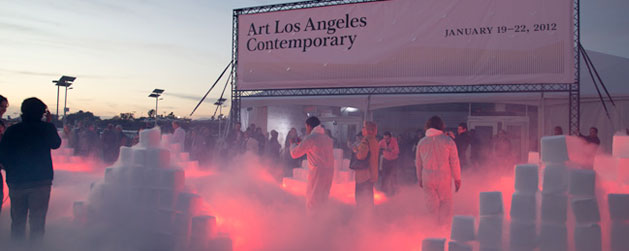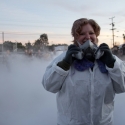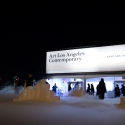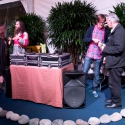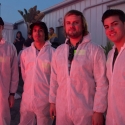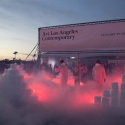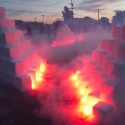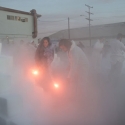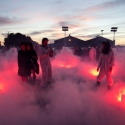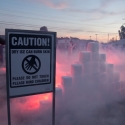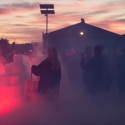Judy Chicago’s Sublime Environments performative installation, opened the Art Los Angeles Contemporary fair this past weekend, and initiated Pacific Standard Time’s 11-day Performance and Public Art Festival. Twenty-five tons of dry ice composed 10 ziggurats, stacked and organized in a large oval just outside the Santa Monica, Barker Hangar entrance.Awestruck patrons were forced to reckon with the powerful array as the drying ice shrouded the entrance with a thick white fog.
Photos by Estée Ochoa
Immediately upon our arrival, a team of volunteers, dressed in white Tyvex jumpsuits, began to organize for the “illumination.” Grouped in pairs, they began to spark flares, arranging them around the base of each ziggurat. The pink fog, created a visual spectacle that complimented the pastel sunset sky. Glenn Phillips, curator at the Getty Research Institute, could not have arranged a better venue for the installation.
Chicago’s piece, originally produced in 1968 as Disappearing Environments, was as much a performance in its initial creation, as it was a temporary sculptural intervention in a consumer environment. Chicago described her 2012 re-staging as a “discovery,” with a new intention – to bridge the gap between generations with fundamental different perceptions of environment, aesthetics and safety.
We caught up with artist, Ashira Siegel, who volunteered on the performance to get an inside perspective on the collaborative experience.
When did you first hear about the performance installation at ALAC?
I heard about “Sublime Environment” through “Materials and Applications” (http://www.emanate.org). M&A is an awesome, Silverlake based, non-profit entity that experiments with art in public spaces and sustainable ideas in building among other things.
What inspired you to volunteer?
I get M & A’s emails. They are always doing really cool projects that I can never participate in because of timing and a hectic life, but there was no way I was going to miss an opportunity to work with Judy Chicago if I could help it!
Please describe your involvement and the process of the project and illumination performance.
The process was surprisingly very collaborative. I thought we were just going to be rebuilding Judy Chicago’s original piece, but it ended up being super hands on. We had discussions and workshops over the course of four months where we experimented with dry ice and flares, discussed possible alternatives to the ziggurat, built those possible alternatives in sugar cubes, discussed some more, and finally decided to go with the design we ultimately did which was nine ziggurats. We added a tenth ziggurat the day of the performance.
M & A is regarded for their sustainable solutions. Were there any discussions or hesitations regarding the issue of carbon dioxide?
There definitely was hesitation and discussion. This was brought up in the first workshop. They looked into many alternatives but nothing compares to dry ice. Primarily, they wanted to keep the integrity of the original installation.
[Co-founder of Materials & Applications, Oliver Hess explained, “We tried using different materials, like mixing corn starch with compressed rain water, to try to get that thick fog. But there’s nothing like dry ice. We just had to use it to get that kind of ephemeral atmosphere.”]
What were your impressions of meeting and working with Judy Chicago?
Judy Chicago is no-nonsense when she is working (and when we were working). She is extremely focused on the task at hand, but is also a true teacher in the sense that she turns questions into discussions when possible and then asks more questions to get us thinking. Judy had the final say on the design of course, but gave thorough consideration to the volunteers as artists in our own right. She was respectful of each of us as individuals, interested in our ideas, and appreciative that we were there actually doing the hard work and making this piece with her. She has a confidence and energy that I very much admire and respect.
You were not born the first time Chicago produced Disappearing Environments. How do you imagine this performance is different, more than 30 years later?
I’m sure there were more restrictions and safety concerns than there was in the sixties. Also – we had way more people, like 30-something volunteer builders carrying the 60 lb. dry ice blocks versus the 3 people in the original piece.
What did this performance speak to you and how did if feel being involved?
It felt like a gift to be involved in Sublime Environment – like I won a lottery. But the truth is that anyone could have signed up and I think that accessibility is also part of the beauty of the piece. The actual hard labor of building the piece (brick by 60 pound, dry ice brick) throughout the day, methodically lighting the flares and placing them in a specific way, and then stepping back to watch the pink glow as the sky turned dark is a moment I’ll never forget. I loved how enchanted people seemed to feel being surrounded by the cold dry ice fog hugging the ground and the smoky bright pink light of the flares. It’s something special to see a sea of faces softly being transformed by an artistic expression that you are creating. It’s very powerful.
Sometimes I am very sentimental and want to hold on to things that are more ephemeral. This was a solid reminder that sometimes the beauty is in the details of a moment, of a physical labor of love, of the chance to sit back for a minute and watch something beautiful that you can’t actually ever hold onto. Sometimes things disappear and the only thing you can do is let it go because you physically have no other choice. It’s a nice way to relearn this lesson.
By Estée Ochoa
